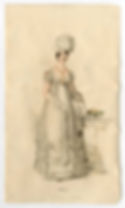Fashion in Jane Austen’s era: A very brief and visual overview
- Zeina Makky
- Feb 26, 2020
- 2 min read
Updated: Sep 15, 2020

Jane Austen was born in 1775, when the rococo style (very ornate, flowery) had already reached its apotheosis and was on its way out. However, some of the fashion remained. Women’s clothes were still ornate, featuring bows, lace, and puffs. Court dresses still featured those very wide panniers — cushions strapped to the waist — giving women the distinct shape you see above. Impractical, yes. But suited if you want to make sure everyone has to stand before the king and queen.
If you fast forward 30 years, the height of style was the exact opposite, and the silhouette couldn’t be more different. It’s hard to find such a radical shift in the modern era, and events of the time contributed to that (the fall of the French monarchy and disgust of ostentation, war, expansion of the British empire to the East).
In this timeline, we take a very quick look at women’s fashion from 1775 to 1817, when Jane Austen died.
1775
Why not start with Marie Antoinette herself in this detail of the painting by Jean-Baptiste André Gautier d’Agoty. It’s the height of ostentation. Bows, furs, lace, jewels, pearls:


This painting by Francis Wheatley depicts a family circa 1775-1780. Even though this is not a court scene, you can see dresses are still pouffy and women’s hair followed the mantra: the bigger the hair, the closer to God.
1792

This fashion plate from 1792 shows a woman very likely wearing panniers under her dress. The waistline is still at the natural waist.
1796 – 1800


The waistline has now gone full empire — under the breastbone. The silhouette is much narrower, and the appearance is overall simpler.
1800

1804

Not all dresses were white or pale, as shown in the fashion plate below.

1806-1808

Hair styles also changed, becoming sleeker, less vertical.

Some women also wore their hair short, à la victime, i.e., cropped as one would have it on the way to the guillotine.
1813


Eastern influences can be seen in the 1813 fashion plate above, left. To the right, some outerwear for a change.
1816

And because fashion is cyclical, what was out once out of style rears its head back, sometimes slightly modified to suit current tastes. Sleeves got puffier, bows and ruffles are back in, although the waistline is still high.
More Information
Here are a few resources for more in-depth information on Georgian and Regency fashion:
Books
“Fashion in the Time of Jane Austen” by Sarah Jane Downing
“Beau Brummell: The Ultimate Man of Style” by Ian Kelly
“Regency Women’s Dress: Techniques and Patterns 1800-1830” by Cassidy Percoco
“Dress in the Age of Jane Austen: Regency Fashion” by Hilary Davidson
Online Resources
Frock Flicks: a blog with sassy reviews of historical costumes in period pieces
American Duchess: The historical costuming blog from the historical shoemaker
Jane Austen Centre: Articles on fashion and furnishings
In case you missed last week’s post, tailor and historical costume builder Samantha Bullat is returning to JASP to talk about fashion, in particular Ottoman and Eastern influences on Friday, June 19 at 9 a.m.. She will also lead workshops on making your own turban 12:30 to 2 p.m. June 19 and 12:45 to 2 p.m. Saturday, June 20. (If you have already registered for JASP and wish to add on the workshops, you do not need to re-register for the program; you may sign up for only the turban-making workshops.)




